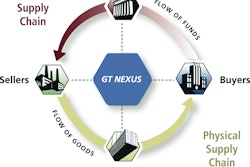
In December 2015, GT Nexus and YouGov surveyed 250 senior manufacturing executives to gauge their outlooks on supply chain in 2016. We set out to learn their top concerns, challenges, goals and opportunities. One message was consistent across the study results: uncertainty. Ranging from technology to disruptions to external factors beyond their control, uncertainty and risk clearly loom overhead in the manufacturing supply chain. Challenges arise from every direction. Customer demands. Political issues. Currency fluctuations. Labor strikes. Raw material costs. Regulations. Risk and uncertainty bare their heads throughout the study. Here are four major ways it is impacting operations, execution and strategy.
The Disruption Factor
Manufacturing continues to be increasingly outsourced. Pressures relating to materials, capacity, compliance, strikes and weather conditions, to name a few, are top concerns for manufacturers and their supply chains.
The 2016 outlook study showed 40 percent of manufacturers have been impacted by a supply chain disruption in the last 12 months. In other research, the numbers are even higher. As manufacturers rely more heavily on outsourced manufacturing and supply chains, the potential of disruption grows, along with the impact. For example, in 2015 the West Coast port slowdown had an estimated $7 billion impact on commerce.
Manufacturers are faced with a tri-fecta of challenges here: rising risk of disruption, growing impacts of a delay, and increasingly demanding customers. Factor in current economic conditions where growth is minimal, and the challenge is further magnified. Manufacturers are forced to move even further beyond their comfort zones to deliver products in new markets and regions to capture growth.
As a result of these dynamics, manufacturers are forced to redesign their supply networks in new ways that minimize disruptions and related risk, while enabling profitable demand fulfillment. For example, there's a movement in many industries to “produce locally, sell locally” to serve overseas markets while keeping costs low. Expect to see more innovative moves in supply network design to address the disruption factor and challenges around fulfilling demand profitably.
Lack of Leadership
Immense focus is being placed on supply chain today from investors, analysts, customers and other constituents. A supply chain disruption or disaster, such as a factory collapse or explosion, brings massive impact to revenue and the brand. Consider other variables, such as currency fluctuations, geo-political crises, changing laws and regulations, or costs of materials and labor, and the quagmire grows more daunting. So much is at stake in a complex environment filled with pitfalls.
This being the case, it's surprising to see so few companies placing supply chain at the C-level. The study shows 76 percent of manufacturers operate without a chief supply chain officer. Consider how many parts of an organization the supply chain touches directly or indirectly. Basically, all of them. The supply chain is an extension of the business. It's the extra-enterprise that has no boundaries. Yet, it has to be managed and controlled. Visibility, transparency, and collaboration are essential to making this happen. Unfortunately, without a strategic C-level leader, supply chain strategies are shorthanded or misguided. Without a champion of end-to-end visibility or a visionary who can move the enterprise toward a supply network approach, many initiatives collapse. As more manufacturers evolve upward in the supply chain maturity curve, the need for chief supply chain officers will become clearer.
Tech Deficiency
In the study we asked manufacturers which technology they believed would most heavily impact their supply chain in 2016. The top three technologies were:
• Advanced analytics (13 percent)
• Internet of Things (11 percent)
• 3D printing (9 percent)
Radio Frequency Identification (RFID) came in at 3 percent and drones at 2 percent. Given these results, technology doesn’t appear to be top of mind for manufacturers. 17 percent said they don’t know what technology will impact their supply chain and over one-third (38 percent) of respondents believe their supply chain will not be impacted by technology. This is problematic and disappointing. There is clearly a need for clarity and education around supply chain technology. If supply chain executives aren’t tracking the latest innovations in collaboration and execution, then their ability to evolve and transform to mitigate risk is greatly marginalized.
Consider the increasingly dispersed nature of supply chain networks today, and the challenges that arise from parties operating on different systems with different workflows and processes. Data and visibility are extremely fragmented. To put it another way, supply chain data that resides in a silo provides no value to the network. When manufacturers can collect and share data across the network and use it for greater visibility and execution, risk is mitigated and opportunities to drive growth spike. Supply chains and their leaders have to be tech-savvy visionaries in 2016.
Conservative Approach: Cost Cutting
Forty-one percent of manufacturing executives in this study said their most important supply chain goal for the near future is reducing costs. Consider the plethora of proactive supply chain strategies being written about and discussed by the Gartners of the world. We hear about visibility, traceability, collaboration, agility, resiliency or a networked environment to align supply and demand. Yet the top response is to cut costs. The clear indication is that uncertainty is driving strategy. As a result, plans are centered on conservative moves to carve out savings and reduce costs, instead of innovating and transforming to drive growth.
Many will say that cutting costs is what you do in a bear market. You pull back, carve out efficiencies. This may be true. But it can't be at the expense of long-term vision and growth. Investments in supply chain visibility provide the foundation for long-term innovation and growth, while setting up new possibilities for removing costs. Moves that reduce inventory. Remove days from cycle times. Extract capital costs from transactions. Or eliminate distribution centers or domestic handling costs.
Cost cutting in 2016 may help the bottom line in the short term. But it’s the strategic supply chain programs that look long term at innovation, network agility and end-to-end visibility--driven by a C-level executive--that will deliver the winning formula in 2016 and beyond.
Supply Chain Risk by the Numbers
40% - Percentage of manufacturers impacted by a supply chain disruption in the last 12 months.
76% - The percentage of manufacturers operating without a chief supply chain officer.
38% - Respondents who believed their supply chain will not be impacted by technology.
41% - Manufacturing executives reporting their most important supply chain goal is reducing costs.











